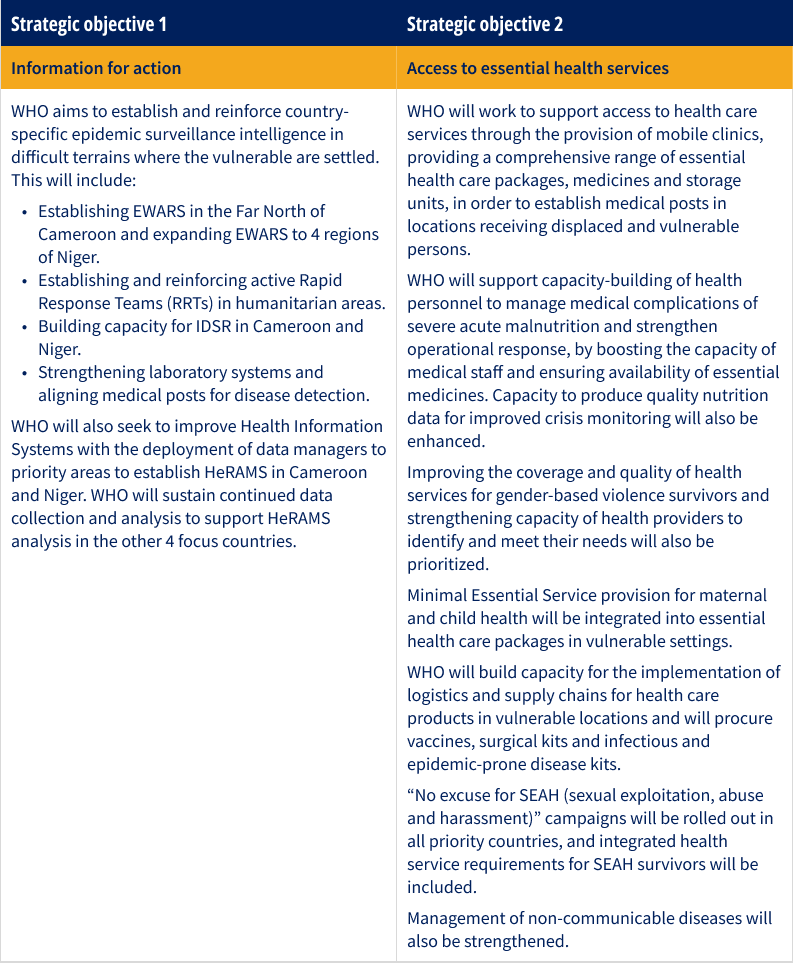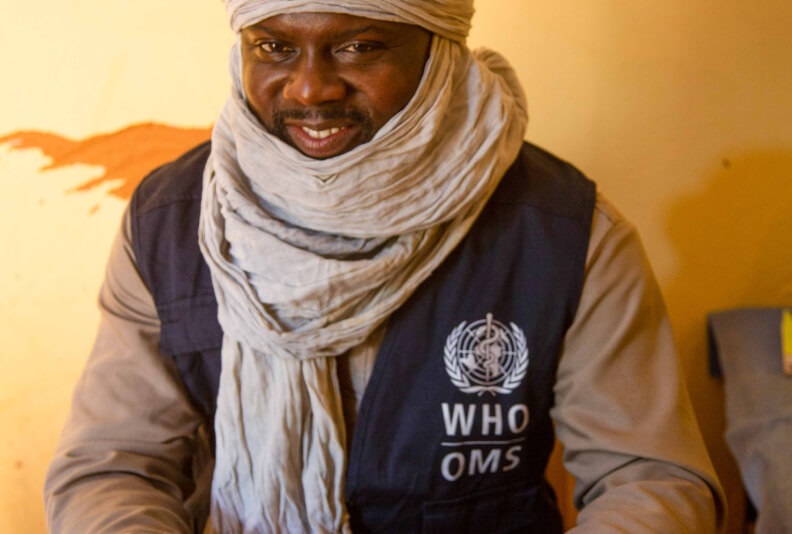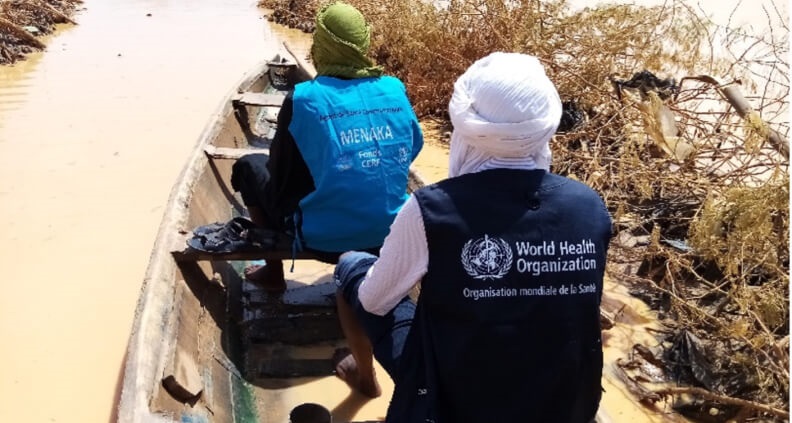
The Sahel
The Sahel
- Requirements (US$):160.1 million
Context
The Sahel crisis is one of the fastest growing, yet most forgotten crises in the world. The region is facing unprecedented humanitarian needs due to armed conflict, food insecurity, climate change, disease, loss of livelihoods and political instability.
In 2023, more than 37.75 million people across Burkina Faso, the Far North of Cameroon, Chad, Mali, Niger and northeast Nigeria will need life-saving assistance.
Access to health care has become challenging due to the COVID-19 pandemic, increasing violence and damaged health facilities. The number of new displacements in central Sahel is accelerating. Security incidents, attacks and kidnappings have become a daily reality for millions. The already high risk of food insecurity is compounded by the consequences of COVID-19, climate change and consequences of the war in Ukraine.
Emergency response
WHO’s emergency work in the six priority countries (Burkina Faso, Cameroon, Chad, Mali, Niger and Nigeria) is guided by the Emergency Response Framework (ERF), which sets out the Organization’s critical functions and core commitments in emergency response. This includes leadership; partner coordination; information and planning; health operations and technical expertise; operations support and logistics, and finance and administration.
With the continuing deterioration of the humanitarian health situation in the Sahel, WHO is intensifying its role both as support to health authorities in strengthening health systems and as a provider of health services. In 2022, WHO graded the Sahel as a Grade 2 acute emergency and set up an Incident Management Support Team in Dakar, Senegal. A disbursement from the Contingency Fund for Emergencies (CFE) of US$ 8.3 million was released to allow for a rapid scale-up of operations. All six countries within the region have established dedicated Incident Management Teams, which are coordinated by the new Sahel Command Center with 11 full-time staff, hosted in WHO’s regional emergency hub in Dakar.

WHO will work with the health authorities and health cluster partners in the six priority countries in the Sahel to strengthen epidemic surveillance and health management information systems (HMIS). To improve the detection of outbreaks of epidemic-prone diseases such as cholera and meningitis, WHO will establish its Early Warning and Response System (EWARS) in parts of Cameroon and Niger, strengthening capacities for Integrated Disease Surveillance and Response (IDSR). WHO will also improve the coverage of the Surveillance System for Attacks on Health Care (SSA), and will strengthen the monitoring of health resources and services availability (HeRAMS)to allow for better planning.
WHO will establish new mobile clinics offering services including routine immunizations against vaccine-preventable diseases, diagnostics and treatment of malaria and pneumonia, and onward referrals for complex conditions to strengthen access to health services by vulnerable populations, including internally displaced persons (IDPs) and refugees.
A specific focus on reproductive, maternal, newborn, child and adolescent health will be strengthened to ensure no one is left behind. WHO is also committed to improving coverage and quality of health services for survivors of gender-based violence (GBV), which remains a challenge in the Sahel, through training health care workers and partners. WHO is also committed to preventing and responding to sexual exploitation, abuse and harassment with a zero-tolerance approach.
To prepare for and respond to the increasing burden of food insecurity and associated health consequences, WHO will strengthen the human resource capacities in the priority countries, to help detect and manage malnutrition and its medical complications.
Strategic objectives



Burkina Faso
- People in need: 4.65 million
- People targeted: 3.14 million
- Funding requirements: 12.3 million
Burkina Faso continues to experience high insecurity due to political instability. More than 1.7 million people were forced to leave their homes in 2022 and are now living in precarious conditions. Since January 2022, 79 alerts relating to a security threat have already been published. The demand for health care has increased sharply as attacks further impact and reduce the number of functional health facilities. Numerous epidemics are affecting the population, particularly measles, polio, cholera, COVID-19 and Hepatitis E, resulting in serious health and socio-economic consequences. As of October 31, 2022, 606 health facilities had been affected by insecurity across the eight regions most affected by the current crisis, of which 32% are now completely closed. In 2023, a total of 2.8 million people will need urgent health care.
WHO is committed to ensuring equitable access to quality health services and strengthening health systems in the context of these security crises, with a particular focus on enhancing preparedness capacities, especially in relation to health information management. The Organization’s response priorities include deploying mobile clinics to provide essential physical and mental health care, strengthening transfusion capacity and availability of oxygen for the management of malnourished children, ensuring the vaccination of internally displaced people and host communities against preventable diseases and distributing health emergency kits (cholera, COVID-19, gender-based violence, trauma, dignity kits). WHO will also prioritize building resilience through community education and awareness-raising.
Cameroon
- People in need: 4.7 million
- People targeted: 2.8 million
- Funding requirements: 22.3 million
Cameroon continues to experience humanitarian and health impacts from ongoing security crises, which currently affect seven of the 10 regions in the country. As of October 2022, there were an estimated total of 481 000 Central African and Nigerian refugees in Cameroon, one million internally displaced persons (IDPs) and 519 000 returnees or former internally displaced persons who had returned to the main regions affected by armed conflict and terrorist attacks.
Since October 2021, Cameroon has been facing the longest and the mostwidespread cholera outbreak since 1970. The country also faces other epidemics such as mpox, polio, yellow fever, measles and COVID-19. WHO’s support will ensure equitable access to quality health services in the context of these security crises, thereby improving outbreak response. The Organization’s response priorities include deploying mobile clinics to provide essential health care, e.g., for reproductive health services. Support will be offered for dignified and safe deliveries for vulnerable women and gender-based violence cases will be referred to the protection sector. Focus will be placed on establishing an early warning and rapid response to epidemics mechanism for regions in crisis, as well as strengthening the management of physical and psychological trauma for people affected by crises. In response to the ongoing COVID-19 pandemic, a key objective for WHO will be to support the national vaccination campaign to increase COVID-19 vaccination coverage rates. WHO will also prioritize building resilience through community education, awareness-raising and empowerment.
Chad
- People in need: 6.9 million
- People targeted: 4.5 million
- Funding requirements: 10.8 million
The humanitarian crisis in Chad is impacted by multiple factors, including ongoing armed conflicts, economic fragility, a precarious health context, and the impacts of climate change, floods, acute food insecurity and associated infectious disease epidemics. More than 2.1 million people are experiencing food and nutrition insecurity in Chad.
The decline in agro-pastoral productivity is affecting the nutritional status of the population. Since September 2022, heavy rains have battered the country's south, causing the Chari and Logone rivers, which meet in the capital city of N'Djamena, to overflow their banks, forcing 149,936 people to flee their homes and take refuge in public spaces.
Chad is affected by circulating vaccine-derived poliovirus type 2 (cVDPV2).
WHO’s response strategy will focus on scaling up its response in collaboration with existing health facilities and Health Cluster partners, enabling mobile clinics in areas that are difficult to access or are without functional health facilities, improving early warning systems and implementing community-based surveillance for early detection of potential epidemic diseases.

WHO doctor and community health worker going to the community for surveillance and awareness raising, Menaka, 2022.
Mali
- People in need: 9 million
- People targeted: 6.2 million
- Funding requirements: 15.5 million
The humanitarian situation in Mali deteriorated significantly over the first half of 2022 due to the intensification of internal conflict and intercommunity clashes. The level of need is at its highest since the conflict crisis began in 2012. Currently, 7.5 million people, or one in three Malians, are in need of humanitarian assistance, up from 3.8 million in 2017. The number of internally displaced persons (IDPs) is increasing and more than 350,000 people have had to flee their homes. In addition, 1.8 million people are in need of food aid - a 50% increase from last year. As of November 2022, a total of 32 755 confirmed COVID-19 cases have been reported in the country, including 742 deaths. The case fatality rate is among the highest in West Africa (2%). Vaccination coverage against COVID-19 during this period was just 9.76%.
WHO’s priorities in Mali include building capacity of health care workers through training and technical supervision and reinforcing access to quality health care, including monitoring the Minimum Package of Activities and Complementary Package of Activities. Mobile clinics and information and referral systems will be strengthened, and greater support offered to conduct vaccination sessions for children targeted under the Expanded Vaccination Program. WHO will also strengthen preparedness and response for disease outbreaks, including COVID-19, measles and other diseases. This will be underpinned by the strengthening of the health information system and by enhancing preparedness and response capacities. The Organization will also work to ensure that populations, especially those impacted by gender-based violence, have access to psychosocial support services.
Niger
- People in need: 4.2 million
- People targeted: 2.3 million
- Funding requirements: 12.9 million
Niger is currently experiencing complex and protracted emergencies. The security situation in the country remains precarious and volatile in the border areas between Burkina Faso, Mali and Nigeria, marked by an upsurge in attacks by non-state armed groups. In 2022, the country experienced four health crises related to epidemics (meningitis, measles, polio and cholera) in addition to cyclical natural disasters due to the geographic environment, e.g. floods, drought, food crisis, COVID-19 and the risk of emerging and re-emerging diseases.
WHO aims to employ several strategies including supporting existing health structures to ensure equitable access to health care, deploying mobile clinics and temporary structures in refugee camps, setting up early warning systems in fragile and hard-to-reach areas, enhancing preparedness and response capacities, and strengthening the surveillance of diseases with epidemiological potential.
Nigeria
- People in need: 8.3 million
- People targeted: 5.4 million
- Funding requirements: 81.6 million
Tens of thousands of people have been killed and millions internally displaced since Boko Haram launched its campaign in 2009, creating one of the world's worst humanitarian crises and causing a near-total breakdown in education and health services.
Throughout the northeast region, the violence has destroyed schools, hospitals and other social facilities, leaving affected communities, particularly women and children, in urgent need of assistance. Nigeria is currently a grade 2 emergency, and is witnessing various floods as well as outbreaks of cholera, monkeypox, measles and yellow fever.
WHO is working to enhance capacities to respond to emergencies, including through the strengthening of lab services and risk communication and community engagement (RCCE) training and implementation. In the northeast, WHO’s response aims to support the continued provision of essential health services including gender-based violence, mental health and psychosocial support, and strengthening the health system while rapidly responding to acute health emergencies through local capacities. This will complement the overall humanitarian response, addressing health needs detailed in the Humanitarian Response Plan - 2022 and the yearly rolling WHO response plan to the northeast including coordination of the health sector.
Funding requirements


Overall financial requirements for the Sahel by country and by response pillar ( US$’000)


For more information
Magdalene Armah | Incident Manager Sahel Crisis | [email protected]
Kerstin Bycroft | External Relations Officer, WHO HQ | [email protected]

